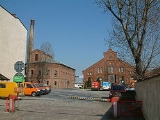
Gasworks
Encyclopedia
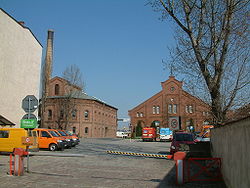
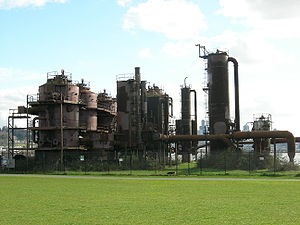
Natural gas
Natural gas is a naturally occurring gas mixture consisting primarily of methane, typically with 0–20% higher hydrocarbons . It is found associated with other hydrocarbon fuel, in coal beds, as methane clathrates, and is an important fuel source and a major feedstock for fertilizers.Most natural...
has made many redundant in the developed world, however they are often still used for storage.
Early gasworks
Coal gasCoal gas
Coal gas is a flammable gaseous fuel made by the destructive distillation of coal containing a variety of calorific gases including hydrogen, carbon monoxide, methane and volatile hydrocarbons together with small quantities of non-calorific gases such as carbon dioxide and nitrogen...
was introduced to Great Britain
Great Britain
Great Britain or Britain is an island situated to the northwest of Continental Europe. It is the ninth largest island in the world, and the largest European island, as well as the largest of the British Isles...
in the 1790s as an illuminating gas by the Scottish
Scottish people
The Scottish people , or Scots, are a nation and ethnic group native to Scotland. Historically they emerged from an amalgamation of the Picts and Gaels, incorporating neighbouring Britons to the south as well as invading Germanic peoples such as the Anglo-Saxons and the Norse.In modern use,...
inventor William Murdoch
William Murdoch
William Murdoch was a Scottish engineer and long-term inventor.Murdoch was employed by the firm of Boulton and Watt and worked for them in Cornwall, as a steam engine erector for ten years, spending most of the rest of his life in Birmingham, England.He was the inventor of the oscillating steam...
.
Early gasworks were usually located beside a river
River
A river is a natural watercourse, usually freshwater, flowing towards an ocean, a lake, a sea, or another river. In a few cases, a river simply flows into the ground or dries up completely before reaching another body of water. Small rivers may also be called by several other names, including...
or canal
Canal
Canals are man-made channels for water. There are two types of canal:#Waterways: navigable transportation canals used for carrying ships and boats shipping goods and conveying people, further subdivided into two kinds:...
so that coal
Coal
Coal is a combustible black or brownish-black sedimentary rock usually occurring in rock strata in layers or veins called coal beds or coal seams. The harder forms, such as anthracite coal, can be regarded as metamorphic rock because of later exposure to elevated temperature and pressure...
could be brought in by barge
Barge
A barge is a flat-bottomed boat, built mainly for river and canal transport of heavy goods. Some barges are not self-propelled and need to be towed by tugboats or pushed by towboats...
. Transport was later shifted to railways and many gasworks had internal railway systems with their own locomotives.
Early gasworks were built for factories in the Industrial Revolution from about 1805 as a light source and for industrial processes requiring gas, and for lighting in country houses from about 1845. Country house gas works are extant at Culzean Castle
Culzean Castle
Culzean Castle is a castle near Maybole, Carrick, on the Ayrshire coast of Scotland. It is the former home of the Marquess of Ailsa but is now owned by the National Trust for Scotland...
in Scotland and Owlpen
Owlpen Manor
Owlpen Manor is a Tudor Grade I listed manor house of the Mander family, situated in the village of Owlpen in the Stroud district in Gloucestershire, England. There is an associated estate set in a picturesque valley within the Cotswold Area of Outstanding Natural Beauty...
in Gloucestershire
Gloucestershire
Gloucestershire is a county in South West England. The county comprises part of the Cotswold Hills, part of the flat fertile valley of the River Severn, and the entire Forest of Dean....
.
Equipment
A gasworks was divided into several sections for the production, purification and storage of gas.Retort house
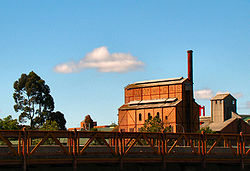
Retort
In a chemistry laboratory, a retort is a glassware device used for distillation or dry distillation of substances. It consists of a spherical vessel with a long downward-pointing neck. The liquid to be distilled is placed in the vessel and heated...
s in which coal was heated to generate the gas. The crude gas passed on to the condenser
Condenser
Condenser may refer to:*Condenser , a device or unit used to condense vapor into liquid. More specific articles on some types include:*Air coil used in HVAC refrigeration systems...
. The residue left in the retort was coke
Coke (fuel)
Coke is the solid carbonaceous material derived from destructive distillation of low-ash, low-sulfur bituminous coal. Cokes from coal are grey, hard, and porous. While coke can be formed naturally, the commonly used form is man-made.- History :...
.
Condenser
This consisted of a bank of air-cooled gas pipes over a water-filled sump. Its purpose was to remove tarTar
Tar is modified pitch produced primarily from the wood and roots of pine by destructive distillation under pyrolysis. Production and trade in tar was a major contributor in the economies of Northern Europe and Colonial America. Its main use was in preserving wooden vessels against rot. The largest...
from the gas by its condensing
Condensation
Condensation is the change of the physical state of matter from gaseous phase into liquid phase, and is the reverse of vaporization. When the transition happens from the gaseous phase into the solid phase directly, the change is called deposition....
out as the gas was cooled.
Scrubber
A tower, packed with coke, down which water was trickled. This removed ammoniaAmmonia
Ammonia is a compound of nitrogen and hydrogen with the formula . It is a colourless gas with a characteristic pungent odour. Ammonia contributes significantly to the nutritional needs of terrestrial organisms by serving as a precursor to food and fertilizers. Ammonia, either directly or...
and ammonium
Ammonium
The ammonium cation is a positively charged polyatomic cation with the chemical formula NH. It is formed by the protonation of ammonia...
compounds.
Purifier
This removed hydrogen sulfideHydrogen sulfide
Hydrogen sulfide is the chemical compound with the formula . It is a colorless, very poisonous, flammable gas with the characteristic foul odor of expired eggs perceptible at concentrations as low as 0.00047 parts per million...
from the gas by passing it over trays containing moist ferric oxide. The gas then passed on to the gasholder.
Gasholder
The gasholder or gasometer was a tank used for storage of the gas and to maintain even pressure in distribution pipes.By-products
The by-products of gas-making, such as cokeCoke (fuel)
Coke is the solid carbonaceous material derived from destructive distillation of low-ash, low-sulfur bituminous coal. Cokes from coal are grey, hard, and porous. While coke can be formed naturally, the commonly used form is man-made.- History :...
, coal tar
Coal tar
Coal tar is a brown or black liquid of extremely high viscosity, which smells of naphthalene and aromatic hydrocarbons. Coal tar is among the by-products when coal iscarbonized to make coke or gasified to make coal gas...
, ammonia
Ammonia
Ammonia is a compound of nitrogen and hydrogen with the formula . It is a colourless gas with a characteristic pungent odour. Ammonia contributes significantly to the nutritional needs of terrestrial organisms by serving as a precursor to food and fertilizers. Ammonia, either directly or...
and sulfur
Sulfur
Sulfur or sulphur is the chemical element with atomic number 16. In the periodic table it is represented by the symbol S. It is an abundant, multivalent non-metal. Under normal conditions, sulfur atoms form cyclic octatomic molecules with chemical formula S8. Elemental sulfur is a bright yellow...
had many uses. For details, see coal gas
Coal gas
Coal gas is a flammable gaseous fuel made by the destructive distillation of coal containing a variety of calorific gases including hydrogen, carbon monoxide, methane and volatile hydrocarbons together with small quantities of non-calorific gases such as carbon dioxide and nitrogen...
.
British gasworks today
Coal gas is no longer made in the UK but many gasworks sites are still used for storage and metering of natural gasNatural gas
Natural gas is a naturally occurring gas mixture consisting primarily of methane, typically with 0–20% higher hydrocarbons . It is found associated with other hydrocarbon fuel, in coal beds, as methane clathrates, and is an important fuel source and a major feedstock for fertilizers.Most natural...
and some of the old gasometers are still in use. Fakenham
Fakenham
Fakenham is a town and civil parish in Norfolk, England. It is situated on the River Wensum, some north east of King's Lynn, south west of Cromer, and north west of Norwich....
gasworks dating from 1846 is the only complete, non-operational gasworks remaining in England. Other examples exist at Biggar
Biggar, South Lanarkshire
Biggar is a town and former burgh in South Lanarkshire, Scotland. It is situated in the Southern Uplands, near the River Clyde, around 30 miles from Edinburgh along the A702. The closest towns are Lanark and Peebles, and as such Biggar serves a wide rural area...
in Scotland
Scotland
Scotland is a country that is part of the United Kingdom. Occupying the northern third of the island of Great Britain, it shares a border with England to the south and is bounded by the North Sea to the east, the Atlantic Ocean to the north and west, and the North Channel and Irish Sea to the...
and Carrickfergus
Carrickfergus
Carrickfergus , known locally and colloquially as "Carrick", is a large town in County Antrim, Northern Ireland. It is located on the north shore of Belfast Lough, from Belfast. The town had a population of 27,201 at the 2001 Census and takes its name from Fergus Mór mac Eirc, the 6th century king...
in Northern Ireland
Northern Ireland
Northern Ireland is one of the four countries of the United Kingdom. Situated in the north-east of the island of Ireland, it shares a border with the Republic of Ireland to the south and west...
.
Photos of Fakenham Gas Works
Gasworks in popular culture
Gasworks were noted for their foul smell and generally located in the poorest areas of metropolitan areas. Cultural remnants of gasworks include many streets named Gas Street or Gas Avenue and groups or gangs known as Gas House GangGas House Gang (disambiguation)
Gas House Gang may refer to:* the Gas House Gang, a New York street gang during the late 19th century* the Gas House Gang , a barbershop quartet* the Gashouse Gang, the 1934 St. Louis Cardinals baseball team...
, such as the 1934 St. Louis Cardinals
St. Louis Cardinals
The St. Louis Cardinals are a professional baseball team based in St. Louis, Missouri. They are members of the Central Division in the National League of Major League Baseball. The Cardinals have won eleven World Series championships, the most of any National League team, and second overall only to...
.
Railway Gasworks
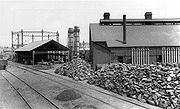
New South Wales Government Railways
The New South Wales Government Railways was the government department that operated the New South Wales Government's railways until the establishment of the Public Transport Commission in 1972. Although later known officially as the Department of Railways, New South Wales, it was still generally...
manufactured its own oil-gas for this purpose, together with reticulated coal-gas to railway stations and associated infrastructure. Such works were established at the Macdonaldtown
Macdonaldtown, New South Wales
Macdonaldtown is an urban locality in Sydney, in the state of New South Wales, Australia. Macdonaldtown is located 4 kilometres south-west of the Sydney central business district, within the suburb of Newtown and adjacent to Erskineville. Macdonaldtown is part of the local government area of the...
Carriage Sheds [also known as the Eveleigh plant], Newcastle
Newcastle, New South Wales
The Newcastle metropolitan area is the second most populated area in the Australian state of New South Wales and includes most of the Newcastle and Lake Macquarie Local Government Areas...
, Bathurst
Bathurst, New South Wales
-CBD and suburbs:Bathurst's CBD is located on William, George, Howick, Russell, and Durham Streets. The CBD is approximately 25 hectares and surrounds two city blocks. Within this block layout is banking, government services, shopping centres, retail shops, a park* and monuments...
, Junee
Junee, New South Wales
Junee is a medium sized town in the Riverina region of New South Wales, Australia. The town's prosperity and mixed services economy is based on a combination of agriculture, rail transport, light industry and government services, and in particular correctional services...
and Werris Creek
Werris Creek, New South Wales
Werris Creek is a small town in New South Wales, Australia, near Tamworth, in Liverpool Plains Shire. It is north of Quirindi and is at the junction of the Main North railway line to Armidale and Moree. At the 2006 census, Werris Creek had a population of 1,490.-History:The area is thought to...
. These plants followed on from the works of a private supplier which the railway took over in 1884.
Gas was also transported in special travelling gas reservoir wagons from the gasworks to stationary reservoirs located at a number of country stations where carriage reservoirs were replenished.
With the spreading conversion to electric power for lighting buildings and carriages during ther 1920s and 1930s, the railway gasworks were progressively decommissioned.
Gasworks Brisbane, Australia
The Gasworks site in Brisbane Australia has been a stalwart of the river’s edge since its development in 1863. By 1890, the Works were supplying gas to Brisbane streets from Toowong to Hamilton (Hackner, D. Ed. (1996) p. 7) and over the next 100 years, it would grow to supply Brisbane city with the latest in gas technology until it was decommissioned in 1996.In March 1866, the Queensland Defence Force placed an official request for town gas connection, evidence of the vital role the Gasworks played in the economic development of colonial Brisbane (Lambert, J.T 1996. p9). In fact, the Gasworks were considered to be of such importance, that during World War II, genuine fears of attack from Japanese air raids motivated the installation of anti aircraft guns which vigilantly watched over the plant and its employees throughout the war (Lambert, J.T 1996. p10).
The site itself has been synonymous with economic growth and benefit to Brisbane and Queensland with the success of the Gasworks facilitating further development of the Newstead/Teneriffe area to include the James Hardie fibro-cement
Fibro
Fibro, the shortened form of "Fibrous Cement" - or "Fibrous Asbestos Cement", FAC, is a building material made of compressed fibres cemented into rigid sheets....
manufacturing plant, Shell Oil plant, Brisbane Water and Sewerage Depot and even the “Brisbane Gas Company Cookery School” which operated in the 1940s. In 1954, a carbonizing plant was built, giving Brisbane the “most modern gas producing plant in Australia” (Lambert, J.T 1996. p10), consuming 100 tonnes of coal every eight hours.
During its golden years in the late 19th and early 20th centuries, the site also played a vital role in providing employment to Aboriginal Australians and many migrant workers arriving here from Europe after the second World War.
The fine tradition of the Brisbane Gasworks economic and employment-based successes will not be lost or forgotten with the Teneriffe Gasworks Village Development paying homage to the sites history and integrity in its pending urban development.
The Gasholder structure at this site is set to become a hub of a new property development on the site – keeping the structural integrity of the pig iron structure. It will be a true reflection of urban renewal embracing its industrial past.
Technopolis (Gazi)
Located in Athens, Greece Technopolis (Gazi) is an gasworks converted to an exhibition space.The Gas Museum Leicester
The Gas Museum Leicester, UK is operated by the The National Gas Museum TrustThe National Gas Museum Trust
The National Gas Museum Trust is a United Kingdom charitable trust , established in 1997 to take over the responsibility for the UK's two former gas museums.-Formations and objectives:...
.

